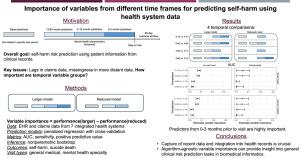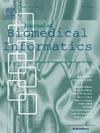利用医疗系统数据预测自残时不同时间段变量的重要性。
IF 4
2区 医学
Q2 COMPUTER SCIENCE, INTERDISCIPLINARY APPLICATIONS
引用次数: 0
摘要
目的:利用医疗系统数据(电子健康记录和保险理赔信息)开发的自残风险预测模型通常会使用患者在进行预测时的就诊指数之前长达数年的信息。可能无法获得所有患者在某些时间段的测量数据。利用算法诊断变量重要性框架,我们研究了指数就诊前不同时间段相应变量的预测潜力,并展示了变量重要性技术在生物医学信息学中的应用:我们使用七个医疗系统的数据,利用变量重要性来量化近期(指数就诊前三个月内)和远期(指数就诊前一年以上)患者心理健康信息预测自残风险的潜力。我们将重要性量化为预测任务中排除相关变量集后预测性的下降幅度。我们使用判别指标来定义预测性:接收者操作特征曲线下面积(AUC)、灵敏度和阳性预测值:结果:与指标就诊前三个月相对应的心理健康预测因子显示出强烈的重要性信号;在一种情况下,排除这些变量后,AUC 从 0.85 降至 0.77。与更远的信息相对应的预测因子则不那么重要:讨论:指标就诊前几个月的预测因素非常重要。在预测时近期数据不完全可用(例如,由于保险理赔处理的滞后性)的情况下,自残预测模型的实施可能具有挑战性:结论:不同时间段的临床变量在预测自残时表现出不同程度的重要性。鉴于现实世界数据的局限性,变量重要性分析可以为是否以及如何在临床实践中实施风险预测模型提供信息。这些分析可更广泛地应用于生物医学信息学研究,为一般临床风险预测任务提供见解。本文章由计算机程序翻译,如有差异,请以英文原文为准。

Importance of variables from different time frames for predicting self-harm using health system data
Objective:
Self-harm risk prediction models developed using health system data (electronic health records and insurance claims information) often use patient information from up to several years prior to the index visit when the prediction is made. Measurements from some time periods may not be available for all patients. Using the framework of algorithm-agnostic variable importance, we study the predictive potential of variables corresponding to different time horizons prior to the index visit and demonstrate the application of variable importance techniques in the biomedical informatics setting.
Materials and Methods:
We use variable importance to quantify the potential of recent (up to three months before the index visit) and distant (more than one year before the index visit) patient mental health information for predicting self-harm risk using data from seven health systems. We quantify importance as the decrease in predictiveness when the variable set of interest is excluded from the prediction task. We define predictiveness using discriminative metrics: area under the receiver operating characteristic curve (AUC), sensitivity, and positive predictive value.
Results:
Mental health predictors corresponding to the three months prior to the index visit show strong signal of importance; in one setting, excluding these variables decreased AUC from 0.85 to 0.77. Predictors corresponding to more distant information were less important.
Discussion:
Predictors from the months immediately preceding the index visit are highly important. Implementation of self-harm prediction models may be challenging in settings where recent data are not completely available (e.g., due to lags in insurance claims processing) at the time a prediction is made.
Conclusion:
Clinically derived variables from different time frames exhibit varying levels of importance for predicting self-harm. Variable importance analyses can inform whether and how to implement risk prediction models into clinical practice given real-world data limitations. These analyses be applied more broadly in biomedical informatics research to provide insight into general clinical risk prediction tasks.
求助全文
通过发布文献求助,成功后即可免费获取论文全文。
去求助
来源期刊

Journal of Biomedical Informatics
医学-计算机:跨学科应用
CiteScore
8.90
自引率
6.70%
发文量
243
审稿时长
32 days
期刊介绍:
The Journal of Biomedical Informatics reflects a commitment to high-quality original research papers, reviews, and commentaries in the area of biomedical informatics methodology. Although we publish articles motivated by applications in the biomedical sciences (for example, clinical medicine, health care, population health, and translational bioinformatics), the journal emphasizes reports of new methodologies and techniques that have general applicability and that form the basis for the evolving science of biomedical informatics. Articles on medical devices; evaluations of implemented systems (including clinical trials of information technologies); or papers that provide insight into a biological process, a specific disease, or treatment options would generally be more suitable for publication in other venues. Papers on applications of signal processing and image analysis are often more suitable for biomedical engineering journals or other informatics journals, although we do publish papers that emphasize the information management and knowledge representation/modeling issues that arise in the storage and use of biological signals and images. System descriptions are welcome if they illustrate and substantiate the underlying methodology that is the principal focus of the report and an effort is made to address the generalizability and/or range of application of that methodology. Note also that, given the international nature of JBI, papers that deal with specific languages other than English, or with country-specific health systems or approaches, are acceptable for JBI only if they offer generalizable lessons that are relevant to the broad JBI readership, regardless of their country, language, culture, or health system.
 求助内容:
求助内容: 应助结果提醒方式:
应助结果提醒方式:


